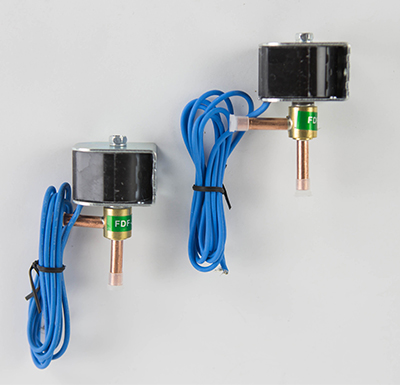HVAC SOLENOID VALVE

ఉత్పత్తి వివరణ
HVAC SOLENOID VALVE
Egret series hvac solenoid valve is an electromechanical valve, used to control the refrigerant or water autonomously and remotely in the air conditioning system. There's a solenoid coil on the top, which is used for controlling the valve by passing an electrical current thru it. In the meantime, HVAC liquid line solenoid valve will create an electromagnetic zone, thus, to control the valve. In other words, there's no need of engineer to physically operate, the hvac solenoid valve will do autonomously. As a result, it will save a lot of labor, and make the system running more safely & efficiently. In general, you can find solenoid valve in many industries, washing machines, HVAC, etc.
Working Principle of HVAC solenoid valve
A solenoid valve furnace consists of three key parts
Solenoid coil: This coil, when energized with electricity, creates a magnetic field.
Plunger: This metal core sits inside the coil and moves up and down when influenced by the magnetic field.
Valve seat: This opening controls the flow of gas. It's connected to the plunger and opens or closes depending on its position.
The Magic of Magnetism
When you turn on your thermostat and demand heat, the control board sends an electrical current to the solenoid coil. This current energizes the coil, generating a magnetic field. The magnetic field, in turn, pulls the plunger upwards, lifting it away from the valve seat. This opens the valve, allowing gas to flow freely through the system and ignite the burner, ultimately warming your home.
When the Heat Fades
Once the desired temperature is reached, the thermostat sends a signal to the control board, cutting off the power to the solenoid coil. The magnetic field disappears, and the plunger, under the influence of a spring or gravity, returns to its original position, closing the HVAC liquid line solenoid valve and stopping the flow of gas.
Beyond Furnaces
Solenoid valve in HVAC aren't limited to just furnaces. They play a vital role in various HVAC systems, including:
Air conditioners: HVAC solenoid controls the flow of refrigerant for cooling.
Humidifiers: They regulate the flow of water for humidity control.
Irrigation systems: Solenoid HVAC controls the flow of water to sprinklers.
HVAC Solenoid Valve Specifications
Model Movement Pattern Diameter Flow Internal Leakage Actions pressure [Mpa] Takeover OD
[mm] [mL/min] Max Min
FDF-1-2A Normally Close Φ1.9 38 ≤100 3.4 0 Φ6
FDF-1-3A Φ3.0 110 ≤300 3.4 0 Φ8
FDF-1-4A Φ4.0 196 ≤500 3.4 0 Φ6
FDF-1-6A Φ6.0 367 ≤500 3.4 0 Φ8
Features of HVAC Solenoid Valve
CLASSIFICATION
AC current normally closes the solenoid valve in HVAC
DC current normally closes the HVAC liquid line solenoid valve
COMPONENTS
Composed of a valve body & electromagnetic coils
Control the opening and closing of the hvac solenoid valve by on-off electromagnetic coils.
FEATURES
Small sizes, Low power consumption
Stability & Reliable performance
OPTIONS
Connection sizes to fit your system
Available with straight–thru or right-angle design
Process of HVAC Solenoid Valve Production
NO.1
The process of an HVAC solenoid valve is not complicated.
First, we use a turning lathe and CNC milling machines, to cutting and machining different sizes of plungers, valve seats, and electromagnetic coils. There are φ3,φ6,φ8, etc.
NO.2
Second, melting the copper material, and pour the melting copper into the copper casting mold to produce the ball valve body.
NO.3
Third, to make spherical-shaped steel ball with a hole in the middle, which controls the flow.
NO.4
Forth, use the argon arc welding method, to assemble the connection port to the ball valve body, in the meanwhile assembling the ball and other parts.
NO.5
Fifth, use PTFE sealing method and the copper sealing cap to make sure air tight.

